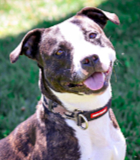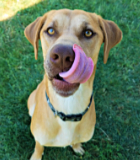TRAINING – LEASH MANNERS
- This topic has 0 replies, 1 voice, and was last updated 16 years, 4 months ago by
Mackenzie’s Admin.
-
AuthorPosts
-
January 23, 2009 at 2:43 am #324
Mackenzie’s Admin
MemberDogs have to be taught to walk nicely on a leash. They are not born knowing that they shouldn’t pull or lag behind, after all. Teaching leash manners can be challenging, primarily because dogs are wildly excited about going for walks, and they find it so rewarding to do their own thing. Some dogs are determined to get where they are going as fast as they possibly can; other dogs want to stop, sniff, and urinate on anything and everything in their path. If you plan to teach your dog to walk nicely on a loose leash, it is critical that you never allow the dog to be rewarded for pulling. If you are inconsistent, your dog will continue to pull because sometimes it pays off. This means that even if you’re in a hurry to take the dog out, you can’t relax the rules and permit the dog to pull!
You may have seen “obedience dogs” at shows or on TV who prance alongside their handlers, staring up with rapt attention. These dogs have been trained in precision heeling. While this looks incredible, it is not something a dog can do for long periods of time. Precision heeling demands constant attention from both dog and handler and is not appropriate for your daily walks around the block or to the park. Even these dogs have been taught basic manners to be able to walk along on a loose leash.
There are various methods for teaching a dog to walk without pulling. No one method works for all dogs. There are certain rules that ought to be followed no matter which approach you opt for:
– Until your dog learns to walk without pulling, all walks are training sessions. Keep training sessions frequent, short, and fun for the dog.
– Teaching a dog to walk without pulling requires plenty of rewards. Use highly desirable treats that the dog does not have access to at other times. Soft treats are best so the dog can eat them quickly. Most dogs love sliced wieners, small cubes of cheese, cut-up pieces of cooked chicken, small chunks of jerky treat and freeze-dried liver.
– You’ll be more successful if you find a way to tire the dog out before taking him for a training walk. Dogs pull in part because they are filled with excess energy, and unless you can expend that energy, it will be very hard for your dog to control himself. Play fetch in the hallway or backyard, play a vigorous game of tug, or drive the dog to the park so he can play with his buddies before you attempt to teach him to walk nicely on leash.
– Walk at a good, quick pace. If the dog is trotting or running, he has less opportunity to catch a whiff of something enticing, and he is less inclined to stop and eliminate every few steps. You are far more interesting to the dog when you move quickly.
– All dogs need to sniff and eliminate on walks. Some dogs take forever choosing the exact best spot on which to urinate or defecate! Allow your dog a certain amount of time, then say, “Okay hurry up,” and give a light tug on the collar. Give him another 30 seconds and repeat, “Okay, let’s walk,” in a firmer tone of voice. Pull the dog away from the spot and resume walking. This way you are giving your dog a warning—and if he really wants to urinate in that spot, he knows he has 30 seconds in which to do it!
– If you expect your dog to be controlled while walking on leash, you must also expect him to be controlled before you go for the walk. If your dog gets wildly excited as you prepare to go for a walk, you need to start your training at this point. Walk to the door and pick up the leash. If your dog is racing back and forth from you to the door, barking, whining, spinning, or jumping up, stop and ask your dog to sit. If the dog continues to be wild, put the leash down and go sit and read the paper. Try again a few minutes later. Continue until the dog actually does sit. Praise and reach to put the leash on the dog. If he jumps out of the sit, drop the leash, stand up tall, and say “Sit.” Wait. When the dog sits, try again. This is tedious training that will make your first few attempts to go for a walk very taxing on your patience! But eventually you will have a dog who can sit and wait while you attach his leash to his collar and open the door. The next step is teaching the dog to walk without pulling on the leash!
Option 1:
Walk in your intended direction. The moment you feel the dog pulling on the leash, stop dead in your tracks and wait. When the dog stops pulling (maybe he turns to see what you’re doing), call him back to you. When he comes to you, ask him to sit. When he does, say “Yes,” give him a treat, and resume walking. With any luck, your dog will look up at you because of the tasty treat. Immediately say “Yes” and give another treat while you keep walking. If the dog pulls again, repeat the same steps: stop dead and wait, when the dog relaxes the pressure on the leash, call him to you, have him sit, say “Yes” and give a treat, then resume walking. Take every opportunity to reward the dog for staying next to you and/or looking up at you, while continuing to walk. If you do this consistently, the dog learns two things: (1) if he stays near you or looks at you, he gets treats and he gets to keep moving, and (2) if he pulls on the leash, it’s a pain in the butt because he doesn’t get to keep moving AND he has to come back to you and sit. If you see that your dog is pulling toward an object to sniff or eliminate, follow the same rules but when the dog comes back and sits by you, say “Yes” and release him to go to the object (provided you are close enough that he doesn’t need to pull). After a few days or weeks, you will find yourself stopping less frequently. Make sure you continue to reward your dog for good behavior or he will regress back to pulling.Option 2:
Before you begin walking, call your dog’s name to get his attention. When he looks up at you, show him that you have a few tasty treats in your free hand. Hold your hand in front of your dog’s face so he is looking at the treats, maybe even trying to nibble at one. Say “Let’s walk,” and move in your intended direction. Every few seconds, pop a small treat into the dog’s mouth. Praise your dog for walking along at your pace. If the dog stops and sniffs or pulls ahead, stop and gain your dog’s attention. Have him sit, show him the treats, and start again. Gradually, over days or weeks, pull your hand up closer to your body. If your dog jumps up to get the treat, say “uh uh” and tuck your hand in tight to your body. When all four of his feet are back on the ground, say “Good!” and reposition your hand. When you reward the dog, reach down to his face to pop the treat in his mouth. When he can walk along without pulling and with your hand in a more natural position beside your body, tuck your hand in a pocket. Continue to reward frequently. Eventually you should be able to walk with your hand comfortably at your side, reaching into your pocket to grab a treat to reward the dog. Over time, gradually increase the amount of time between treats so your dog is walking along for longer distances between treats.Option 3 (not for use on dogs wearing a choke or pinch/prong collar):
For some dogs, stopping and waiting or luring with treats is not sufficient to give them the idea that they shouldn’t pull. Instead of stopping, teach the dog that when he pulls, it’s a signal for you to turn and walk back the way you came. You need to incorporate a warning into this sequence. Before your dog reaches the end of the leash, say “Easy.” If he slows down, say “Yes!” and call him back to you for a treat as you keep moving. If he does not slow down but gets to the end of the leash and starts pulling, don’t say anything to the dog. Just turn abruptly so your dog will check himself at the end of the leash. As your dog runs to catch up to you, praise him. When he reaches you, turn and walk in your original direction. If he pulls again, turn around again. He will learn that pulling is unpleasant because he gets checked against the end of the leash AND he gets farther away from his destination. Be sure to follow the same instructions as above for rewarding the dog when he walks without pulling.**** Be advised that if your dog is RUNNING at full speed toward the end of the leash, you could inflict physical damage to his neck if you allow him to check himself against the leash without giving him any slack. Allow your arm to absorb most of the force when you turn so the dog is surprised but not harmed.
Option 4 (not for use on dogs wearing a choke or pinch/prong collar):
More resistant dogs may need a jerk on the collar when they pull. You need to incorporate a warning into this sequence. Before your dog reaches the end of the leash, say “Easy.” If he slows down, say “Yes” and call him back to you for a treat as you keep moving. If he does not slow down but gets to the end of the leash and starts pulling, say, “I said, easy,” in a firm tone, and jerk back on the leash so the dog feels pressure on the front of his neck. To do this, you will need to reach your arm forward a few inches to give yourself the slack on the leash to jerk back. Make sure your action is a jerk and not a pull. You may need to do this a couple of times before the dog slows down. How much pressure you exert when you jerk back depends on the dog. If your dog is small or sensitive, you will need only slight force. If your dog is large and tenacious, you may need a stronger arm.**** Be advised that if you apply an inordinate amount of effort when you jerk on the dog’s collar, you can inflict physical damage to the neck. A dog’s trachea is susceptible to bruising, so be extremely cautious when using this approach.
What sort of equipment should you use?
While you are teaching your dog not to pull on the leash, you should use a 4- or 6-foot leash. Use a width and a material that are comfortable for your hand. Chain leashes are awkward to use and should be avoided unless you have a dog who easily chews through leashes. There are elasticized leashes (made of “bungee” material) that work well to discourage pulling in some dogs. Extendable leashes, such as the FlexiTM, or leashes longer than 6 feet are appropriate for giving the dog exercise while on leash but are inappropriate for teaching a dog not to pull.GOOD Collar Choices:
– A regular buckle collar
– A martingale collar (also called a limited slip collar)
– A head halter/head collar (such as the Halti™, Gentle Leader™, Snoot Loop™)
– A no-pull harness (such as the Sensation™ or the Lupi™)
– The head halters and no-pull harnesses may decrease pulling without additional training.UNSUITABLE Collar Choices:
– A regular body harness (actually encourages pulling)
– A fabric or metal choke/check collar (may be effective for your dog if used under the guidance of a certified trainer)
– A pinch/prong collar (may be effective for your dog if used under the guidance of a certified trainer)Dogs who Resist Walking on Leash
There are dogs who are reluctant to walk on leash—and instead of pulling, they freeze or turn and pull back toward home. Often such dogs are fearful, and they need a boost in confidence to feel comfortable walking on leash.One approach is to lure the dog along by holding tasty treats in front of his face. If the dog is not too afraid, he should follow the treats and gradually will become more comfortable walking with you.
A second method is to stop a few feet in front of the dog and wait when he freezes. If the dog shows any signs of moving toward you, say “Yes!” and reach to the dog to deliver a treat. Walk a few more feet away and again, wait for the dog to voluntarily move toward you. Praise and reward the dog for forward movement only.
The third method is only appropriate for small- to medium-sized dogs who will walk for stretches at a time, but then balk for no apparent reason. Have the dog wear a regular body harness, and pick the dog up by the back of the harness and move him a few feet along. This will often “jump start” the dog to move again. Say “Yes!” and offer a treat when the dog begins to move. Try to anticipate when the dog will balk and lure him along with treats so that he never stops.
Whatever method you choose, sometimes it can help to start out by walking the dog in less frightening environments. Instead of walking on a busy road, opt for a quiet residential street or a path through the park. When the dog develops a level of comfort in the low-key places, gradually progress to busier areas.
Your dog may respond well if you ask him to engage in other behaviors when he stops forward movement. Ask the dog to sit, down, make eye contact, shake a paw, or execute any convenient behavior that he knows and enjoys performing. Sometimes this helps the dog forget why he was nervous, and so he begins walking again. Of course, you must always praise and reward him for performing these behaviors.
Fearful and insecure dogs benefit from low-key exposure to the world. Rather than going for a walk, try sitting on bench and just hang out with the dog. Talk to him and periodically give him treats when you see any signs that he’s relaxing in the situation.
-
AuthorPosts
- You must be logged in to reply to this topic.












































